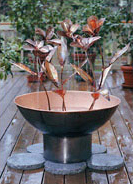The Dawn of a New Bronze Age
 The Oregon Copper Bowl Company makes an assortment of hand-crafted copper items for both house and garden. Shown is the "Dancing Water" fountain with an antique copper patina.
The Oregon Copper Bowl Company makes an assortment of hand-crafted copper items for both house and garden. Shown is the "Dancing Water" fountain with an antique copper patina.High-resolution version of this photo.
The period in man's development known as the Bronze Age began in 3000 B.C. as copper implements, instead of stone, began appearing in mankind's toolboxes.
Bronze - a mix of copper and tin - gets top billing in the history books, even though the Copper Age ( 5500-3000 B.C.) preceded it. Copper was the first metal used in any quantity by man, and it was only during the final stage of the Bronze Age (around 1600 B.C.) that an increase in tin imports spurred the use of bronze in Egypt.
Bronze is harder than pure copper, so the Egyptians used it for weapons, armor, tools and, most famously, sculptures. It is particularly well suited for sculpture because it expands when heated (filling the nooks and crannies of a mold), then contracts as it cools so the sculpture is easy to remove from the mold.
Examples of bronze metalwork found among King Tut's belongings include: sculptures of a dog and snake, a scimitar or sword, a spatula, candlesticks and a trumpet - one of the earliest examples of musical instruments in history.
Today, bronze remains one of the world's preeminent metals. Famous artworks like Auguste Rodin's The Thinker were cast in bronze using the same techniques developed by the Egyptians. Thousands of years later, sculptors still rely on this process, called the "lost wax" method, to produce works of art.
Today, you might say we're undergoing a new Bronze Age as consumers embrace bronze and copper products for their home's interiors and exteriors. Decorative bronze and copper sculptures and fountains have become a fixture in many yards, as the popularity of outdoor living spaces spurs a need for al fresco décor.
Outdoor products made from copper and bronze not only look good, they'll last virtually forever. Unlike iron and steel, copper never rusts; instead, it weathers to form an attractive patina that varies from blue-green to nut-brown depending on the climate where you live.
Distressed or "antique" copper is also a popular decorative option for home interiors and is showing up on faucets, sinks, lighting fixtures and architectural hardware like doorknobs and drawer pulls. Many of these pieces are pretreated to give the metal a weathered, not bright or shiny look.
However, if it's a shine you're after, manufacturers offer a range of copper items such as countertops, appliance fronts and decorative backsplashes in glistening copper. You can even have the copper coated so it never loses its original coloring. However, if you want to take advantage of copper's naturally antimicrobial properties, you should leave it uncoated and let nature do its magic.
For more information on copper and bronze possibilities for home décor, visit our Copper In Your Home section. Cu
Also in this Issue:
- A Golden Age That Never Ends
- The Dawn of a New Bronze Age
- Mother Nature's Masquerade
- New Generation of Artisans Discover Copper
